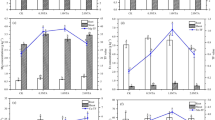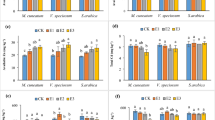Abstract
There is a pollution risk when disposing of post-remediation biomass from chelate-assisted metal phytoremediation. To assess this risk, we measured water extractable lead (Pb) in Brassica rapa tissues with ICP-MS, determined if chelated Pb was present with HPLC-MS, and identified Pb storage locations using electron microscopy with x-ray microanalysis. Ethylenediaminetetraacetic acid (EDTA) and ethylenediaminedisuccinic acid (EDDS) were used to enhance Pb movement from contaminated soil to above ground B. rapa tissues. With Pb-EDTA, 92 % (+/−5) of Pb was water extractable from dried tissues and complexed as Pb-EDTA. Electron microscopy and x-ray microanalysis showed Pb stored in xylem vessels. After composting of plant tissues, 79 % (+/−2) of Pb was water extractable and complexed as Pb-EDTA. Total plant Pb accumulation was lower from soils amended with EDDS, but only 6.7 % (+/−0.3) of Pb was water extractable from dried tissues and 55 % (+/−25) from wet tissues of plants grown in EDDS-amended soils. Pb-EDDS was detected in tissues but not at quantifiable levels. This work emphasizes the need for proper treatment and disposal of contaminated post-remediation plant tissues, especially when using EDTA. Composting of plant tissues containing Pb-EDTA was shown to significantly reduce waste material volume and slightly reduce the water extractable fraction, but further immobilization of Pb would be necessary to minimize transport risk. Amending Pb-contaminated soils with EDDS can result in plant biomass with a lower potential to leach Pb into groundwater, but the lower Pb accumulation with EDDS would require longer phytoremediation time compared with EDTA.




Similar content being viewed by others
References
Ali, H., Khan, E., & Sajad, M. A. (2013). Phytoremediation of heavy metals—concepts and applications. Chemosphere, 91(7), 869–881. doi:10.1016/j.chemosphere.2013.01.075.
Andra, S. S., Datta, R., Sarkar, D., Saminathan, S. K. M., Mullens, C. P., & Bach, S. B. H. (2009). Analysis of phytochelatin complexes in the lead tolerant vetiver grass [Vetiveria zizanioides (L.)] using liquid chromatography and mass spectrometry. Environmental Pollution, 157(7), 2173–2183. doi:10.1016/j.envpol.2009.02.014.
Barrutia, O., Garbisu, C., Hernández-Allica, J., García-Plazaola, J. I., & Becerril, J. M. (2010). Differences in EDTA-assisted metal phytoextraction between metallicolous and non-metallicolous accessions of Rumex acetosa L. Environmental Pollution, 158(5), 1710–1715. doi:10.1016/j.envpol.2009.11.027.
Bovenkamp, G. L., Prange, A., Schumacher, W., Ham, K., Smith, A. P., & Hormes, J. (2013). Lead uptake in diverse plant families: a study applying x-ray absorption near edge spectroscopy. Environmental Science & Technology, 47(9), 4375–4382. doi:10.1021/es302408m.
Bucheli-Witschel, M., & Egli, T. (2001). Environmental fate and microbial degradation of aminopolycarboxylic acids. FEMS Microbiology Reviews, 25(1), 69–106. doi:10.1111/j.1574-6976.2001.tb00572.x.
Chen, K. F., Yeh, T. Y., & Lin, C. F. (2012). Phytoextraction of Cu, Zn, and Pb enhanced by chelators with vetiver (Vetiveria zizanioides): hydroponic and pot experiments. ISRN Ecology, 2012, 1–12. doi:10.5402/2012/729693.
Collins, R. N., Onisko, B. C., McLaughlin, M. J., & Merrington, G. (2001). Determination of metal—EDTA complexes in soil solution and plant xylem by ion chromatography-electrospray mass spectrometry. Environmental Science & Technology, 35(12), 2589–2593. doi:10.1021/es001893y.
Ent, A., Baker, A. J. M., Reeves, R. D., Pollard, A. J., & Schat, H. (2012). Hyperaccumulators of metal and metalloid trace elements: facts and fiction. Plant and Soil, 362(1–2), 319–334. doi:10.1007/s11104-012-1287-3.
Epstein, A. L., Gussman, C. D., Blaylock, M. J., Yermiyahu, U., Huang, J. W., Kapulnik, Y., et al. (1999). EDTA and Pb-EDTA accumulation in Brassica juncea grown in Pb-amended soil. Plant and Soil, 208, 87–94.
Ghosh, M., & Singh, S. P. (2005). A review on phytoremediation of heavy metals and utilization of its byproducts. Applied Ecology and Environmental Research, 3(1), 1–18.
Hu, N., Luo, Y., Wu, L., & Song, J. (2007). A field lysimeter study of heavy metal movement down the profile of soils with multiple metal pollution during chelate-enhanced phytoremediation. International Journal of Phytoremediation, 9(4), 257–268. doi:10.1080/15226510701473476.
Jarvis, M., & Leung, D. W. (2002). Chelated lead transport in Pinus radiata: an ultrastructural study. Environmental and Experimental Botany, 48(1), 21–32. doi:10.1016/S0098-8472(02)00005-9.
Keller, C., Ludwig, C., Davoli, F., & Wochele, J. (2005). Thermal treatment of metal-enriched biomass produced from heavy metal phytoextraction. Environmental Science & Technology, 39(9), 3359–3367. doi:10.1021/es0484101.
Komárek, M., Tlustoš, P., Száková, J., Chrastný, V., & Ettler, V. (2007). The use of maize and poplar in chelant-enhanced phytoextraction of lead from contaminated agricultural soils. Chemosphere, 67(4), 640–651. doi:10.1016/j.chemosphere.2006.11.010.
Kos, B., & Leštan, D. (2003). Induced phytoextraction/soil washing of lead using biodegradable chelate and permeable barriers. Environmental Science & Technology, 37(3), 624–629. doi:10.1021/es0200793.
Lan, J., Zhang, S., Lin, H., Li, T., Xu, X., Li, Y., et al. (2013). Efficiency of biodegradable EDDS, NTA and APAM on enhancing the phytoextraction of cadmium by Siegesbeckia orientalis L. grown in Cd-contaminated soils. Chemosphere, 91(9), 1362–1367. doi:10.1016/j.chemosphere.2013.01.116.
Li, H., Wang, Q., Cui, Y., Dong, Y., & Christie, P. (2005). Slow release chelate enhancement of lead phytoextraction by corn (Zea mays L.) from contaminated soil—a preliminary study. Science of the Total Environment, 339(1–3), 179–187. doi:10.1016/j.scitotenv.2004.07.020.
Lin, C., Liu, J., Liu, L., Zhu, T., Sheng, L., & Wang, D. (2009). Soil amendment application frequency contributes to phytoextraction of lead by sunflower at different nutrient levels. Environmental and Experimental Botany, 65(2–3), 410–416. doi:10.1016/j.envexpbot.2008.12.003.
Liu, W., Zhou, Q., Zhang, Z., Hua, T., & Cai, Z. (2011). Evaluation of cadmium phytoremediation potential in Chinese cabbage cultivars. Journal of Agricultural and Food Chemistry, 59(15), 8324–8330. doi:10.1021/jf201454w.
Luo, C., Shen, Z., & Li, X. (2005). Enhanced phytoextraction of Cu, Pb, Zn and Cd with EDTA and EDDS. Chemosphere, 59(1), 1–11. doi:10.1016/j.chemosphere.2004.09.100.
Meers, E., Ruttens, A., Hopgood, M. J., Samson, D., & Tack, F. M. G. (2005). Comparison of EDTA and EDDS as potential soil amendments for enhanced phytoextraction of heavy metals. Chemosphere, 58(8), 1011–1022. doi:10.1016/j.chemosphere.2004.09.047.
Meers, E., Tack, F. M. G., Van Slycken, S., Ruttens, A., Du Laing, G., Vangronsveld, J., et al. (2008). Chemically assisted phytoextraction: a review of potential soil amendments for increasing plant uptake of heavy metals. International Journal of Phytoremediation, 10(5), 390–414. doi:10.1080/15226510802100515.
Moreno, D. A., Víllora, G., Hernández, J., Castilla, N., & Romero, L. (2002). Accumulation of Zn, Cd, Cu, and Pb in Chinese cabbage as influenced by climatic conditions under protected cultivation. Journal of Agricultural and Food Chemistry, 50(7), 1964–1969. doi:10.1021/jf011142v.
Mulligan, C. N., Yong, R. N., & Gibbs, B. F. (2001). Remediation technologies for metal-contaminated soils and groundwater: an evaluation. Engineering Geology, 60(1–4), 193–207. doi:10.1016/S0013-7952(00)00101-0.
Neugschwandtner, R. W., Tlustoš, P., Komárek, M., & Száková, J. (2008). Phytoextraction of Pb and Cd from a contaminated agricultural soil using different EDTA application regimes: laboratory versus field scale measures of efficiency. Geoderma, 144(3–4), 446–454. doi:10.1016/j.geoderma.2007.11.021.
Nowack, B., Schulin, R., & Robinson, B. H. (2006). Critical assessment of chelant-enhanced metal phytoextraction. Environmental Science & Technology, 40(17), 5225–5232. doi:10.1021/es0604919.
Padmavathiamma, P. K., & Li, L. Y. (2007). Phytoremediation technology: hyper-accumulation metals in plants. Water, Air, and Soil Pollution, 184(1–4), 105–126. doi:10.1007/s11270-007-9401-5.
Rascio, N., & Navari-Izzo, F. (2011). Heavy metal hyperaccumulating plants: how and why do they do it? And what makes them so interesting? Plant Science, 180(2), 169–181. doi:10.1016/j.plantsci.2010.08.016.
Reynolds, E. S. (1963). The use of lead citrate at high pH as an electron-opaque stain in electron microscopy. The Journal of Cell Biology, 17(1), 208–212. doi:10.1083/jcb.17.1.208.
Saifullah, Meers, E., Qadir, M., de Caritat, P., Tack, F. M. G., Du Laing, G., et al. (2009). EDTA-assisted Pb phytoextraction. Chemosphere, 74(10), 1279–1291. doi:10.1016/j.chemosphere.2008.11.007.
Sarret, G., Vangronsveld, J., Manceau, A., Musso, M., D’Haen, J., Menthonnex, J.-J., et al. (2001). Accumulation Forms of Zn and Pb in Phaseolus vulgaris in the presence and absence of EDTA. Environmental Science & Technology, 35(13), 2854–2859. doi:10.1021/es000219d.
Sas-Nowosielska, A. (2004). Phytoextraction crop disposal—an unsolved problem. Environmental Pollution, 128(3), 373–379. doi:10.1016/j.envpol.2003.09.012.
Shibata, M., Konno, T., Akaike, R., Xu, Y., Shen, R., & Ma, J. F. (2006). Phytoremediation of Pb contaminated soil with polymer-coated EDTA. Plant and Soil, 290(1–2), 201–208. doi:10.1007/s11104-006-9152-x.
Sun, Y., Zhou, Q., An, J., Liu, W., & Liu, R. (2009). Chelator-enhanced phytoextraction of heavy metals from contaminated soil irrigated by industrial wastewater with the hyperaccumulator plant (Sedum alfredii Hance). Geoderma, 150(1–2), 106–112. doi:10.1016/j.geoderma.2009.01.016.
Tian, S., Lu, L., Yang, X., Huang, H., Brown, P., Labavitch, J., et al. (2011). The impact of EDTA on lead distribution and speciation in the accumulator Sedum alfredii by synchrotron x-ray investigation. Environmental Pollution, 159(3), 782–788. doi:10.1016/j.envpol.2010.11.020.
Vassil, A. D., Kapulnik, Y., Raskin, I., & Salt, D. E. (1998). The role of EDTA in lead transport and accumulation by Indian mustard. Plant Physiology, 117, 447–453.
Wu, G., Kang, H., Zhang, X., Shao, H., Chu, L., & Ruan, C. (2010). A critical review on the bio-removal of hazardous heavy metals from contaminated soils: issues, progress, eco-environmental concerns and opportunities. Journal of Hazardous Materials, 174(1–3), 1–8. doi:10.1016/j.jhazmat.2009.09.113.
Wu, L., Luo, Y., Xing, X., & Christie, P. (2004). EDTA-enhanced phytoremediation of heavy metal contaminated soil with Indian mustard and associated potential leaching risk. Agriculture, Ecosystems & Environment, 102(3), 307–318. doi:10.1016/j.agee.2003.09.002.
Zaier, H., Ghnaya, T., Ben Rejeb, K., Lakhdar, A., Rejeb, S., & Jemal, F. (2010). Effects of EDTA on phytoextraction of heavy metals (Zn, Mn and Pb) from sludge-amended soil with Brassica napus. Bioresource Technology, 101(11), 3978–3983. doi:10.1016/j.biortech.2010.01.035.
Zhao, S., Lian, F., & Duo, L. (2011). EDTA-assisted phytoextraction of heavy metals by turfgrass from municipal solid waste compost using permeable barriers and associated potential leaching risk. Bioresource Technology, 102(2), 621–626. doi:10.1016/j.biortech.2010.08.006.
Zhao, S., Shang, X., & Duo, L. (2012). Accumulation and spatial distribution of Cd, Cr, and Pb in mulberry from municipal solid waste compost following application of EDTA and (NH4)2SO4. Environmental Science and Pollution Research, 20(2), 967–975. doi:10.1007/s11356-012-0992-z.
Acknowledgments
We are grateful to the National Science Foundation for support of this work under Grant no. 0116170 and the Saginaw Bay Watershed Initiative Network for project support. We acknowledge SVSU student Heather Claxton and ACS Project SEED student Robert Woys for their contributions to the experimental work. We also thank Xudong Fan of the Michigan State University Center for Advanced Electron Microscopy and Bruce Hart of the SVSU Independent Testing Laboratory.
Author information
Authors and Affiliations
Corresponding author
Rights and permissions
About this article
Cite this article
Krueger, E., Darland, J., Goldyn, S. et al. Water Leaching of Chelated Pb Complexes from Post-Phytoremediation Biomass. Water Air Soil Pollut 224, 1615 (2013). https://doi.org/10.1007/s11270-013-1615-0
Received:
Accepted:
Published:
DOI: https://doi.org/10.1007/s11270-013-1615-0




